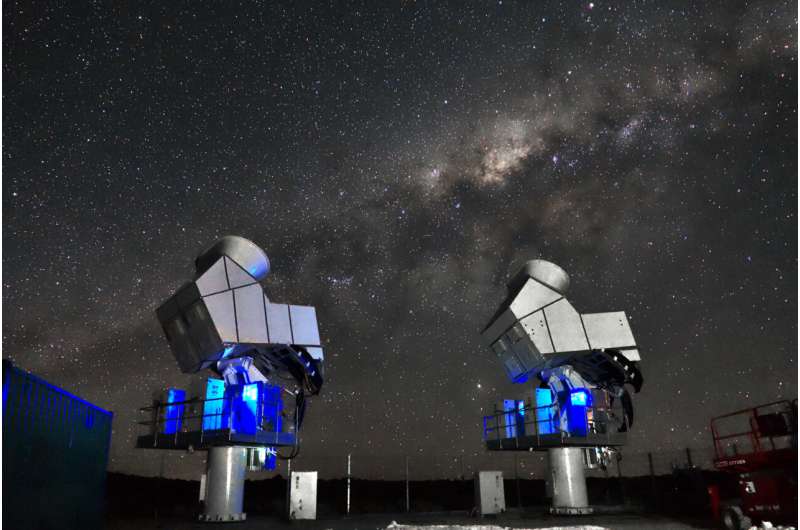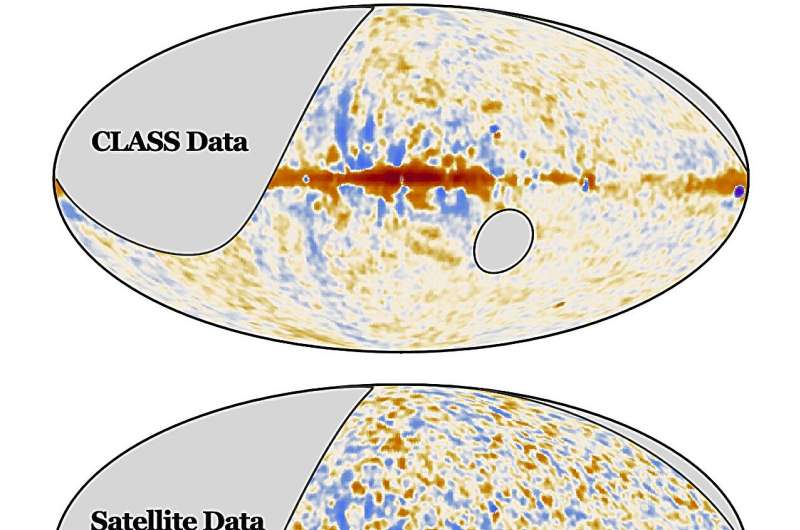This article has been reviewed according to Science X's editorial process and policies. Editors have highlighted the following attributes while ensuring the content's credibility:
fact-checked
peer-reviewed publication
trusted source
proofread
New measurement captures clearer picture of our galaxy and beyond

With unique capabilities to track microwave energy fluctuations, a small observatory in the Andes mountains of northern Chile produced maps of 75% of the sky as part of an effort to measure the universe's origin and evolution more accurately.
The U.S. National Science Foundation Cosmology Large Angular Scale Surveyor (CLASS), a collaboration led by Johns Hopkins University astrophysicists, created the maps. By measuring microwave polarization, or how these energy waves wiggle in particular directions, the team is probing the history and physics of the universe—from the very first moments to when galaxies, stars, and planets formed.
The new maps of the sky and the team's interpretations of them are set to be published in The Astrophysical Journal.
The results significantly improve observations where scientists need to filter out microwaves, a form of invisible light, emitted by our Milky Way galaxy, the team reports. The findings are expected to help scientists gain a better understanding of the cosmic microwave background, the residual radiation of the hot, dense, and young universe that has evolved over its 13.8-billion-year lifetime. Cosmologists use this signal to piece together important evidence about the early universe.
"By studying the polarization of the cosmic microwave background, astrophysicists can infer what the universe must have been like at earlier times," said Tobias Marriage, a Johns Hopkins professor of physics and astronomy who co-leads the team. "Astrophysicists can go back to very, very early times—the initial conditions, the very first moments where the matter in the universe and the distribution of energy was first put in place—and can connect all that to what we see today."
The new CLASS maps provide further insight into a specific signal called linear polarization, which comes from radiation created by fast-moving electrons swirling around the Milky Way's magnetic field. This signal helps scientists study our galaxy, but it can also confuse their view of the early universe.

"The findings dramatically improve our understanding of the physical processes in the early universe that could have created a background of circular polarization, a distinct form of microwave radiation. For linear polarization, the new results have enhanced measurements of the signals from the Milky Way. They show a high degree of agreement and exceed the sensitivity of prior space missions," said Charles L. Bennett, a Bloomberg Distinguished Professor, Alumni Centennial Professor, and a Johns Hopkins Gilman Scholar in physics and astronomy.
"Studying the relict radiation from the beginning of the universe is critical for understanding how the entire cosmos came to be and why it is the way it is," says Nigel Sharp, a program director in NSF's Division of Astronomical Sciences, which has supported the CLASS telescope array since before 2010.
"These new measurements provide essential large-scale details within our growing picture of variations present in the cosmic background radiation—a feat which is particularly impressive because it was achieved using ground-based instruments."
Unlike space missions, the research paves the way for more detailed observations with ground-based telescopes that allow for ongoing instrumentation improvements. The CLASS observatory implemented new technologies, including smooth-walled feeds to guide radiation from space onto detectors, custom-designed detectors, and new polarization modulators. All three of these were developed in collaboration between NASA and Johns Hopkins.
"It's very important to know the brightness of emission from our Milky Way galaxy because this is what we have to correct for to perform a deeper analysis of the cosmic microwave background," said lead author Joseph Eimer, an astrophysicist at Johns Hopkins.
"CLASS is very successful in characterizing the nature of that signal so that we can recognize it and remove those contaminants from observations. The project is at the forefront of pushing ground-based polarization measurements in the largest scales."
The team said the results set a new standard for detecting polarization at the largest scales from a ground-based observatory, offering promising possibilities for future investigations, particularly with the inclusion of additional CLASS data, both already obtained and from ongoing observations.
More information: The Astrophysical Journal (2024). DOI: 10.3847/1538-4357/ad1abf
Journal information: Astrophysical Journal
Provided by Johns Hopkins University




















